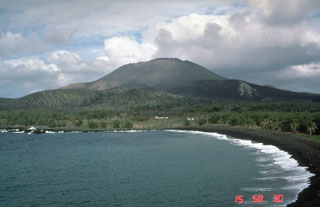Report on Pagan (United States) — April 1984
Scientific Event Alert Network Bulletin, vol. 9, no. 4 (April 1984)
Managing Editor: Lindsay McClelland.
Pagan (United States) Dark eruption columns
Please cite this report as:
Global Volcanism Program, 1984. Report on Pagan (United States) (McClelland, L., ed.). Scientific Event Alert Network Bulletin, 9:4. Smithsonian Institution. https://doi.org/10.5479/si.GVP.SEAN198404-284170
Pagan
United States
18.13°N, 145.8°E; summit elev. 570 m
All times are local (unless otherwise noted)
Visible images from NOAA 7 and NOAA 8 polar-orbiting satellites showed Pagan emitting a small, moisture-laden plume on about half of the days between 29 March and 8 May ([on 29 and 31 March; 1,2,3,4,5,6,8,11,12,14,20,21,23,24,25, and 28 April (weather clouds on 17-19 April); and 1 and 7 May]). When present, the plume extended 100-160 km downwind, with its base at about 0.75 km and its top at about 1.8 km. Occasionally the plume appeared as a haze, when its moisture had been lost downwind. Whether the moisture in the plume was vented by the volcano or acquired from the atmosphere has not been determined.
On 15 May, Pagan erupted twice. At 0825 residents of Agrigan Island, 65 km N, felt an earthquake, rushed from their homes, and saw a dark column rising 2-4 km above Pagan. The eruption cloud, about 50 km in diameter, drifted NW. An Air Force weather reconnaissance plane, diverted to inspect the activity, observed no lava emission. A second moderate eruption occured during the afternoon.
Geological Summary. Pagan Island, the largest and one of the most active of the Mariana Islands volcanoes, consists of two stratovolcanoes connected by a narrow isthmus. Both North and South Pagan stratovolcanoes were constructed within calderas, 7 and 4 km in diameter, respectively. North Pagan at the NE end of the island rises above the flat floor of the northern caldera, which may have formed less than 1,000 years ago. South Pagan is a stratovolcano with an elongated summit containing four distinct craters. Almost all of the recorded eruptions, which date back to the 17th century, have originated from North Pagan. The largest eruption during historical time took place in 1981 and prompted the evacuation of the sparsely populated island.
Information Contacts: M. Matson, NOAA/NESDIS; N. Banks, HVO.

